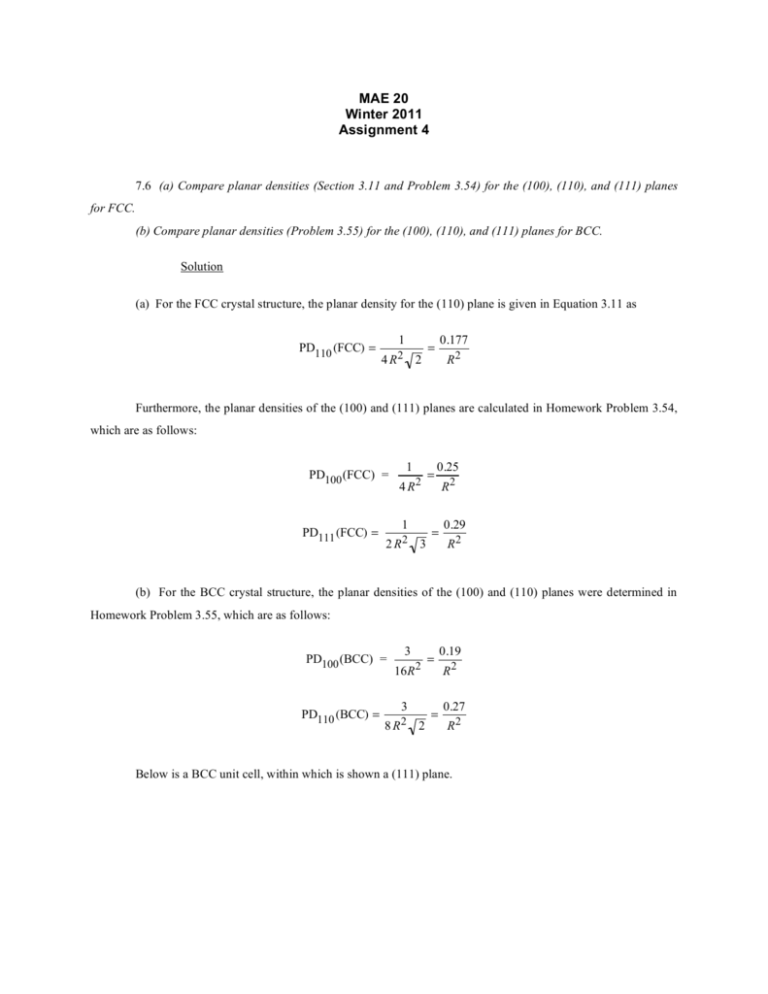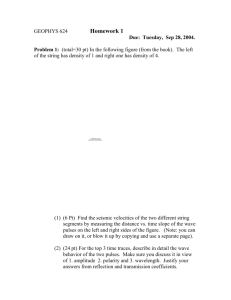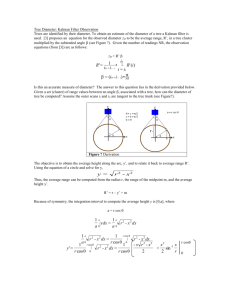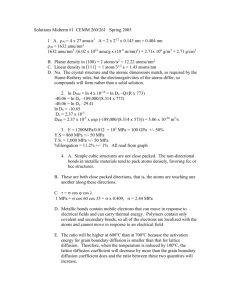Assignment 4 solutions
advertisement

MAE 20
Winter 2011
Assignment 4
7.6 (a) Compare planar densities (Section 3.11 and Problem 3.54) for the (100), (110), and (111) planes
for FCC.
(b) Compare planar densities (Problem 3.55) for the (100), (110), and (111) planes for BCC.
Solution
(a) For the FCC crystal structure, the planar density for the (110) plane is given in Equation 3.11 as
PD110 (FCC) =
1
4 R2
2
0.177
=
R2
Furthermore, the planar densities of the (100) and (111) planes are calculated in Homework Problem 3.54,
which are as follows:
PD100 (FCC) =
PD111 (FCC) =
1
4 R2
1
2 R2
3
=
0.25
=
R2
0.29
R2
(b) For the BCC crystal structure, the planar densities of the (100) and (110) planes were determined in
Homework Problem 3.55, which are as follows:
PD100 (BCC) =
PD110 (BCC) =
3
16R 2
3
8 R2
2
=
=
0.19
R2
0.27
R2
Below is a BCC unit cell, within which is shown a (111) plane.
(a)
The centers of the three corner atoms, denoted by A, B, and C lie on this plane. Furthermore, the (111) plane does
not pass through the center of atom D, which is located at the unit cell center. The atomic packing of this plane is
presented in the following figure; the corresponding atom positions from the Figure (a) are also noted.
(b)
Inasmuch as this plane does not pass through the center of atom D, it is not included in the atom count. One sixth of
each of the three atoms labeled A, B, and C is associated with this plane, which gives an equivalence of one-half
atom.
In Figure (b) the triangle with A, B, and C at its corners is an equilateral triangle. And, from Figure (b), the
xy
area of this triangle is
. The triangle edge length, x, is equal to the length of a face diagonal, as indicated in
2
Figure (a). And its length is related to the unit cell edge length, a, as
x 2 = a 2 + a 2 = 2a 2
or
x=a 2
For BCC, a =
4R
(Equation 3.3), and, therefore,
3
x=
4R 2
3
Also, from Figure (b), with respect to the length y we may write
! x $2
y2 + # & = x2
"2%
which leads to y =
x 3
. And, substitution for the above expression for x yields
2
y=
x 3 ! 4 R 2 $! 3 $ 4 R 2
= ##
&#
&=
2
3 &% #" 2 &%
2
"
Thus, the area of this triangle is equal to
AREA =
! 1 $ ! 4 R 2 $ ! 4 R 2 $ 8 R2
1
x y = # & ##
&#
&=
" 2 %"
2
3 &% #" 2 &%
3
And, finally, the planar density for this (111) plane is
PD111 (BCC) =
0.5 atom
8 R2
=
3
16 R 2
=
0.11
R2
3
7.13 A single crystal of aluminum is oriented for a tensile test such that its slip plane normal makes an angle of
28.1° with the tensile axis. Three possible slip directions make angles of 62.4°, 72.0°, and 81.1° with the same
tensile axis.
(a) Which of these three slip directions is most favored?
(b) If plastic deformation begins at a tensile stress of 1.95 MPa (280 psi), determine the critical resolved
shear stress for aluminum.
Solution
We are asked to compute the critical resolved shear stress for Al. As stipulated in the problem, φ = 28.1°,
while possible values for λ are 62.4°, 72.0°, and 81.1°.
(a) Slip will occur along that direction for which (cos φ cos λ) is a maximum, or, in this case, for the
largest cos λ. Cosines for the possible λ values are given below.
cos(62.4°) = 0.46
cos(72.0°) = 0.31
cos(81.1°) = 0.15
Thus, the slip direction is at an angle of 62.4° with the tensile axis.
(b) From Equation 7.4, the critical resolved shear stress is just
! crss = " y (cos # cos $) max
= (1.95 MPa) [ cos (28.1°) cos (62.4°)] = 0.80 MPa (114 psi) 7.23
7.23 (a) From the plot of yield strength versus (grain diameter)–1/2 for a 70 Cu–30 Zn cartridge brass,
Figure 7.15, determine values for the constants σ0 and ky in Equation 7.7.
(b) Now predict the yield strength of this alloy when the average grain diameter is 1.0 × 10-3 mm.
Solution
(a) Perhaps the easiest way to solve for σ0 and ky in Equation 7.7 is to pick two values each of σy and d-1/2
from Figure 7.15, and then solve two simultaneous equations, which may be created. For example
d-1/2 (mm) -1/2
σy (MPa)
4
75
12
175
The two equations are thus
75 = ! 0 + 4 k y
175 = ! 0 + 12 k y
Solution of these equations yield the values of
k y = 12.5 MPa (mm)1/2
[1810 psi (mm)1/2 ]
σ0 = 25 MPa (3630 psi)
(b) When d = 1.0 × 10-3 mm, d-1/2 = 31.6 mm-1/2, and, using Equation 7.7,
! y = ! 0 + k y d -1/2
1/2 $
!
= (25 MPa) + #12.5 MPa (mm) &(31.6 mm-1/2 ) = 420 MPa (61, 000 psi)
"
%
7.29 Two previously undeformed specimens of the same metal are to be plastically deformed by reducing
their cross-sectional areas. One has a circular cross section, and the other is rectangular; during deformation the
circular cross section is to remain circular, and the rectangular is to remain as such. Their original and deformed
dimensions are as follows:
Circular (diameter, mm)
Rectangular (mm)
Original dimensions
15.2
125 × 175
Deformed dimensions
11.4
75 × 200
Which of these specimens will be the hardest after plastic deformation, and why?
Solution
The hardest specimen will be the one that has experienced the greatest degree of cold work. Therefore, all
we need do is to compute the %CW for each specimen using Equation 7.8. For the circular one
" A ! Ad %
%CW = $ 0
' ( 100
A0
#
&
#!r 2 " !r 2 &
= % 0 2 d ( ) 100
!r0
%$
('
) " 15.2 mm %2
" 11.4 mm %2 ,
+!$
' ( !$
' .
#
&
#
& .
2
2
+
=
/ 100 = 43.8%CW
+
.
" 15.2 mm %2
+
.
!$
'
#
&
2
*
-
For the rectangular one
" (125 mm)(175 mm) ! (75 mm)(200 mm) %
%CW = $
' ( 100 = 31.4%CW
(125 mm)(175 mm)
#
&
Therefore, the deformed circular specimen will be harder.
7.38 The average grain diameter for a brass material was measured as a function of time at 650°C, which
is tabulated below at two different times:
Time (min)
Grain Diameter (mm)
30
3.9 × 10–2
90
6.6 × 10–2
(a) What was the original grain diameter?
(b) What grain diameter would you predict after 150 min at 650°C?
Solution
(a) Using the data given and Equation 7.9 (taking n = 2), we may set up two simultaneous equations with
d0 and K as unknowns; thus
(3.9 ! 10 -2 mm) 2 " d02 = (30 min) K
(6.6 ! 10 -2 mm) 2 " d02 = (90 min) K
Solution of these expressions yields a value for d0, the original grain diameter, of
d0 = 0.01 mm,
and a value for K of 4.73 × 10-5 mm2/min
(b) At 150 min, the diameter d is computed using a rearranged form of Equation 7.9 as
d =
=
d02 + Kt
(0.01 mm) 2 + (4.73 ! 10"5 mm2 /min) (150 min) = 0.085 mm









